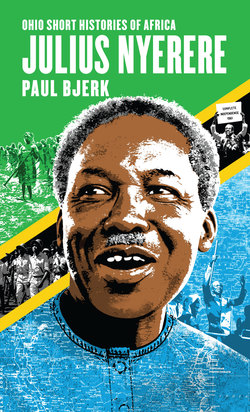Читать книгу Julius Nyerere - Paul Bjerk - Страница 10
На сайте Литреса книга снята с продажи.
Оглавление3
TANU and Tanzanian Independence, 1954–64
“Since my return to Tanganyika,” Julius Nyerere wrote in 1955 to George Shepperson, his former lecturer in Edinburgh, “a few things have happened both to me personally and to the Territory.” Nyerere delighted in wry irony and found humor in downplaying the impact his political activities had already brought in Tanganyika. He had finished at Edinburgh in 1952 and returned home soon after. Now he had catapulted to prominence and was known across the territory as a standard-bearer of the burgeoning independence movement.
But in this letter he wrote more about his marriage with Maria and the birth of his first two children. He blandly mentioned his election the previous year as president of the Tanganyika African Association (TAA), “a sort of socio-political organisation,” he explained. “In July last year we transformed this into the Tanganyika African National Union [TANU], a fully fledged political organisation which pledged itself to work for self-government.”1
TANU’s birth on July 7, 1954, is now regarded as a momentous occasion, and the date is still celebrated as Tanzania’s preeminent national holiday, known as Saba Saba (or “Seven Seven”) Day. It seemed less impressive at the time. That sunny Wednesday morning in the dusty town of Tabora just happened to be the day that an African lobbying group changed its name. But within ten years TANU would control an independent African country, arm liberation movements in Southern Africa, and fend off Cold War intrigue in Zanzibar by annexing that island territory to create a new nation, called Tanzania.
Nyerere went on to explain in the letter that, “as a result of the visit to New York, I lost my job and am now [a] jobless gentleman organising TANU.” His modesty here served a purpose. He knew that TANU’s birth and its future fortunes were not his alone to claim. The growth of TANU was the work of a large group of dedicated men and women who saw themselves not as colonial subjects, but as citizens of a future nation. Muslims and Christians from various parts of the territory, their ethnic and religious differences were of little concern. They set their sights on gaining an African voice in territorial politics. Without these colleagues, Nyerere might well have become an influential educator in Tanganyika, maybe even a politician, but not its transformative first president.
The Birth of TANU
In the early 1950s a group of “Young Turks” took over the leadership of the TAA, a twenty-year-old organization representing the interests of a tiny African middle class of educated civil servants and businessmen. They were anxious to communicate their concerns about the colonial government’s proposals for political reform, which seemed designed to keep African influence to a minimum for decades to come. The new TAA leadership consisted of recent Makerere graduates like Vedastus Kyaruzi, who had been involved in student politics, and older World War II veterans who were now Dar es Salaam businessmen and civil servants like the Sykes brothers, Ally and Abdulwahid.2 Compared to their elders, both groups were much more sophisticated in dealing with European thought and culture, and much less intimidated by the colonial state.
Channeling the activism of its upcountry branches, the new leadership submitted a memorandum to the government protesting any attempt to develop the Tanganyika political system in a way that would give different rights to different racial groups. They proposed a process that would lead to a freely elected government in control of internal affairs by 1962. Through patient negotiation and energetic politics, they got their wish, despite the colonial government’s best efforts to slow their ambitions for self-government.
Nyerere was well known to the TAA’s young leaders because he had studied with some of them. They arranged for his election as president of the TAA in April 1953. They thought he could help reverse the decline of the TAA, which had fallen on hard times, victim to subtle government intimidation and the rising radicalism of other organizations. The Meru Citizens’ Union peacefully brought its case for land reform all the way to the United Nations, while some World War II veterans spoke of “going to the forest” to start a guerrilla movement.3 Nyerere was concerned that rising militancy in some upcountry districts would lead to clashes with the colonial government. He believed that Tanganyika could be liberated from colonial rule, but that violence would only delay independence and sabotage the freedom that followed. He wanted to avoid forcing the government into a defensive crouch, as had happened in Kenya because of the Mau Mau rebellion there.
Nyerere worked with Kyaruzi and the Sykes brothers to rewrite the TAA constitution for its transformation into TANU. They made it a more effective umbrella organization that could coordinate the efforts of various African political groups and better control the policies and statements of branch offices. The new constitution declared their intention to “build up a united nationalism” and “fight relentlessly until Tanganyika is self-governing and independent.”4
“The Atmosphere Has Been Suddenly Revolutionised”
At the July 1954 conference, Nyerere pointed out that since Tanganyika was technically a UN trust territory and not a British colony, they owed no allegiance to the Queen of England. So, when a UN delegation came back with a positive report and recommended independence within the next twenty-five years, the TANU leadership took it as an endorsement of their ambition for independence. They deftly brought about a peaceful transition in a fraction of that time.
